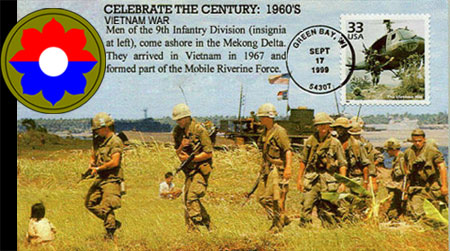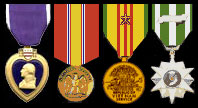| North
High School Wall of Honor Warren Godfrey Harding Lizotte, Jr. Class of June, 1966 |
 |
|||||||||||||||||||||||
| Research done by Rick Nehrling, Class of 1963. | ||||||||||||||||||||||||
| Warren Godfrey Harding Lizotte, Jr. | ||||||||||||||||||||||||
| Warren was a member of North High's class of June, 1966. Warren enlisted in the US Army and, after his training, he arrived in Vietnam on April 5, 1968. His Military Occupational Specialty (MOS) was 11B20 Combat Infantryman and his rank was Specialist Four. He was originally assigned to the 6th Battalion, 31st Infantry, 9th Infantry Division. Later he transferred to E Company, 75th Infantry, 9th Infantry Division. His service number was 16923937. Warren's name is listed on the Vietnam Wall in Washington, D.C. on Panel 31W, Line 069. | ||||||||||||||||||||||||
|
||||||||||||||||||||||||
|
||||||||||||||||||||||||
| The
men of E Company, 75th Infantry of the 9th Infantry Division operated
in both III and IV Corps. They were the 9th Infantry Division's Long
Range Reconnaissance Patrols (LRRPs) that operated in small groups well
away from the protection of US base camps and fire support bases. Later,
these LRRPs were reorganized into Ranger Companies under the organization
of the 75th Ranger Regiment. In late 1967 through 1968, E Company and its LRRP teams worked mostly in the lowlands south of Saigon, the Rung Sat Special Zone, and the Mekong Delta. Torrential rain and year-round water exposed these men to disabling skin diseases, extensive inflammatory lesions, and rampant skin infections, making their area of operation one of the most difficult places to work in South Vietnam. Long Range Reconnaissance Patrol teams usually are comprised of six men and operate independently of one another while working towards a common mission. On February 26, 1969, the 9th Division Headquarters decided to insert three LRRP teams into an area south of Fire Support Base (FSB) Moore (XS 260500). Military intelligence had determined that this area had a high concentration of VC (Viet Cong) soldiers. Late in the afternoon of the 26th, three LRRP teams were combined, totaling 18 soldiers, and loaded onto three Bell UH-1 troop transport helicopters. These helicopters were accompanied by two Cobra gunships and a Light Observation Helicopter used as a scout. The scout helicopter marked two false LZs (Landing Zones) with smoke grenades and then proceeded to the third and real LZ. Again the scout helicopter marked this LZ with a smoke grenade. Unfortunately, this smoke grenade set off an uncontrollable grass fire in the LZ. It was quickly decided not to abort the mission, and the three transport helicopters inserted the LRRPs. The LZ was a small abandoned and not workable rice paddy with wood lines on both sides. The insertion was into a cold LZ with no firing at the LRRPs by the enemy. The fire did not impede the movement of the LRRP teams, but the fire was not a good sign for the soldiers. The soldiers quickly proceeded to get away from the LZ, past the wood line, and into the woods. Nothing happened as they slowly moved through the woods until they stopped for a break. Suddenly a VC walked upon their position. A couple of the soldiers opened up on the VC, and they missed him. Several soldiers chased him into the woods briefly, but found nothing. The LRRPs knew they were in the middle of an area that military intelligence had determined contained a high concentration of VC soldiers. With the firing at the VC who had escaped, the LRRPs realized that the VC soldiers were going to send small squads into the woods to try and locate them. That night the LRRPs set up a night defensive position. Shortly after the LRRPs had established their night defensive position, one of the six-man VC squads walked right into the LRRPs night defensive position. The LRRPs opened up on the VC squad killing all of them. After this initial night contact, one of the LRRPs would later say "a few minutes later all hell broke loose." The VC immediately opened up on the LRRPs night defensive position with small arms and rocket propelled grenades. The VC fire was extremely accurate, wounding 16 of the 18 LRRPs. However, all of the LRRPs were able to maintain their positions and kept up defensive fire to keep the VC at bay. As the LRRPs were fighting, they called into their command center requesting troop support and medivacs. They also slowly moved from the woods into a nearby clearing where helicopters could land. The clearing was so small that it could only accommodate one helicopter at a time. The first helicopter which came in to help the LRRPs was loaded with other soldiers to help the LRRPs on the ground support the area and to extract wounded LRRPs. As the helicopter was descending into the clearing, its tail rotor hit a tree limb, snapping off the helicopter's tail. The helicopter began spinning in circles and crashed just off to the side of the LRRPs perimeter and away from the clearing. None of the helicopter crew nor were any of the soldiers killed. The wounded crew and soldiers were removed from the helicopter. Immediately, the second helicopter descended into the clearing, dropped off its soldiers, and extracted as many wounded as possible. Additional helicopters descended into the clearing dropping off more soldiers and extracting more wounded until all of the wounded had been removed from the battlefield. All 16 of the LRRPs wounded were extracted within three helicopter sorties. One of the LRRPs, Warren Lizotte, would later die from his wounds. From survivors comments, Warren had suffered a serious head wound when the VC opened up on the night defensiver position. The medics were able to keep him alive on the battlefield and through his extraction by the helicopters. Unfortunately, his wounds were so serious that the doctors were unable to save him, and he died in the hospital. At the time of his death, Warren had been in south Vietnam 11 months of the his scheduled 12 month tour. Also,at the time of his death, Warren was married. Warren's service number was 16923937. His name is listed on the Vietnam Wall in Washington, D.C. on Panel 31W, Line 069. |
||||||||||||||||||||||||
|
||||||||||||||||||||||||
|
||||||||||||||||||||||||
| Died: Dinh Tuong Province, South Vietnam; February 26, 1969. Hostile; died of wounds. Ground casualty. | ||||||||||||||||||||||||
| Music: "Ballad of the Green Beret" | ||||||||||||||||||||||||
| Home
|
Back/allyears |
WWI |
WWII |
Korea |
Vietnam |
Afghanistan/Iraq |
Lyrics
|
Refs/Awards |
Contact ©2025-csheddgraphics All rights reserved. All images and content are © copyright of their respective copyright owners. |
||||||||||||||||||||||||







